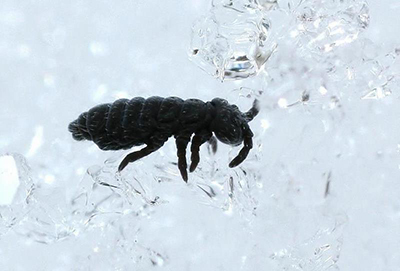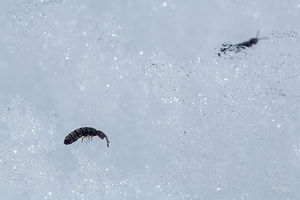Snow flea
Description

| |
| Domain: | Eukaryota |
|---|---|
| Kingdom: | Animalia |
| Phylum: | Arthropoda |
| Subphylum: | Hexapoda |
| Class: | Collembola |
| Order: | Poduromorpha |
| Family: | Hypogastruridae |
| Genus: | Hypogastrura |
Snow fleas are members of the Collembola class and are relatively small (typically around 1.5 to 2 millimeters in length), with as many as six abdominal segments [1]. They are a part of the subclass commonly known as springtails. They have a tubular appendage called a collophore, which protrudes from the first abdominal segment. The collophore used to be thought to be a stabilizing mechanism for the collembola when it jumped by sticking to the surface on which it landed. More recent research has concluded that the collophore is used in osmoregulation, water intake, and excretion [2].
Collembola that live in the upper soil layers are often referred to as Springtails because of a tail-like appendage found among most species, called the furcula. It is a forked appendage attached to the fourth segment by a structure called the retinaculum and is used for jumping when the animal is threatened; it is not used for normal locomotion [3]. These tubes are also thought to play a role in water intake and help the snow fleas adhere to surfaces. Recent flash freeze photography revealed that these tubes could provide direction for the snow flea spring [4].
Snow fleas get their names from their behavior of jumping on top of snow, thus looking similar to fleas. These organisms can maintain life on top of snow cover through their ability to produce a glycine-rich antifreeze-like protein that keeps their bodies from freezing. [5]
Habitat & Distribution
Snow fleas are typically found in leaf litter and other decaying organic material in and on the top layer of soil [6]. They can also be found in the winter months on top of snow, becoming more visible in footprints left behind in the snow.

Springtails, including snow fleas, are one of the most abundant macroscopic animals in the world, with estimates of 100,000 individuals per square meter of ground where soil and moss occur [8]. The only other amimals with global populations of a similar size are thought to be nematodes, crustaceans, and mites. Most springtails are difficult to see with the naked eye with few exceptions, including the snow flea [9].
The distribution of snow fleas is affected by environmental factors such as soil acidity, moisture, and light. Altitudinal changes in species distribution can be at least partially explained by increased acidity at higher elevation, and moisture requirements explain why some species cannot live above ground, or retreat into the soil during dry seasons [12] [13].
Diet
Snow fleas are detritivores, but their diets are very diverse, as they feed on things like leaf litter, living plant material, algae, fungi, and other microorganisms, including protozoans and nematodes. They act as both predators and prey for larger organisms. [4]
Environmental Indicators
Collembola are useful bio-indicators of soil quality. Studies have found that the jumping ability of springtails can be used to evaluate the quality of Cu- and Ni-polluted soils [19]. Snow fleas are sensitive to certain chemicals in the soils, therefore, their appearance in an area can lead to conclusions being made regarding the chemical composition of the surrounding soils. The snow fleas are also known to move spores of mycorrhizal fungi as well as destroying plant pathogens, therefore leading to the conclusion that their presence is an indicator of healthy soils [12].
References
1. Davies, W. Maldwyn (1927). "On the tracheal system of Collembola, with special reference to that of Sminthurus viridis, Lubb" (PDF). Quarterly Journal of Microscopical Science. 71 (281): 15–30.
2. Eisenbeis, G., 1982. Physiological absorption of liquid water by Collembola: absorption by the ventral tube at different salinities. Journal of Insect Physiology 28:11–20.
3. Christian, E., 1978. The jump of the springtails. Naturwissenschaften 65:495-496.
4. Rosovsky, Judy. "An Introduction to Snow Fleas". https://agriculture.vermont.gov/introduction-snow-fleas#:~:text=Snow%20fleas%20have%20a%20structure,and%20away%20from%20potential%20enemies.
5. Lin, Feng-Hsu, "Structural Modeling of Snow Flea Antifreeze Protein". doi: https://doi.org/10.1529/biophysj.106.093435.
6. Hopkin, Stephen P. (1997). "The biology of the Collembola (springtails): the most abundant insects in the world" (PDF). Natural History Museum.
7. Ponge, Jean-François; Arpin, Pierre; Sondag, Francis & Delecour, Ferdinand (1997). "Soil fauna and site assessment in beech stands of the Belgian Ardennes" (PDF). Canadian Journal of Forest Research. 27 (12): 2053–2064. doi:10.1139/cjfr-27-12-2053.
8. Island Creek Elementary School. "Snow Flea. Hypogastrura nivicola". Study of Northern Virginia Ecology. Fairfax County Public Schools.
9.Loranger, Gladys; Bandyopadhyaya, Ipsa; Razaka, Barbara & Ponge, Jean-François (2001). "Does soil acidity explain altitudinal sequences in collembolan communities?" (PDF). Soil Biology and Biochemistry. 33 (3): 381–393. doi:10.1016/S0038-0717(00)00153-X.
10. Detsis, Vassilis (2000). "Vertical distribution of Collembola in deciduous forests under Mediterranean climatic conditions" (PDF). Belgian Journal of Zoology. 130 (Supplement 1): 57–61.
11. Kim, Shin Woong & An, Youn-Joo (2014). "Jumping behavior of the springtail Folsomia candida as a novel soil quality indicator in metal-contaminated soils". Ecological Indicators. 38: 67–71. doi:10.1016/j.ecolind.2013.10.033.
12. Mcilveen (2013). "Snow Fleas". Halton/North Peel Naturalist Club. https://hnpnc.com/site/snow-fleas#:~:text=Snow%20Fleas%20are%20able%20to,certain%20chemicals%20in%20the%20soil.
13. Dove, P. L. (2017, February). Snow Flea [Photograph]. Retrieved from http://www.flickriver.com/photos/pldove/32945915875/
14. University of Minnesota Extension. Snow Flea [Photograph]. Retrieved from https://apps.extension.umn.edu/garden/diagnose/insect/general-curiosity-insects/beetles/small/snow-flea.html